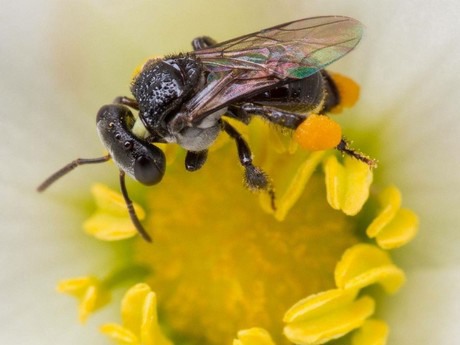Did you know Australia has no native Bumblebees? Bumblebees are important to the pollination process of plants, such as tomatoes. A research project aimed to determine the success of native bees as effective pollinators is bearing fruitful results.
Glasshouse trials at Western Sydney University are finding that native stingless bees are successful pollinators for strawberries in protected cropping environments.
Funded by Hort Innovation and Western Sydney University, through the Hort Frontiers Pollination Program, the trials are using colonies of stingless bees, native to Australia, to demonstrate that these bees could make safe and efficient pollinators resulting in good yields of strawberries with high taste profiles.
Hort Innovation Research and Development Manager for Pollination, Ashley Zamek, said the native stingless bees were introduced into the glasshouse setting before the crops were planted to help them adjust to the protected cropping environment and become accustomed to the food sources available inside the glasshouse.

The Australian native bees species tetragonula carbonaria used in the glasshouse trials
“Once the strawberries flowered, the native bees visit the flowers and researchers measure the relationship between bee visits and subsequent fruit yield, quality and size,” she said.
“Crop pollination in glasshouses is a challenge because European honeybees are not well-suited to the enclosed environment and of course they can sting. This has resulted in some growers pollinating by hand which requires significant manual labour.”
“This project means big things for horticulture. We now know, as a result of these trials that native stingless bees can and will pollinate certain crops successfully in protected cropping environments.”
Project lead from Western Sydney University, Professor James Cook, said the search for a wider variety of pollinators that could perform in protected cropping environments was part of a national push to identify alternative options to European honeybees and assess the potential for using Australia’s many native pollinators more effectively.
“Australia is home to around 2000 species of native bees as well as thousands of species of pollinating moths, flies, butterflies, birds and even bats that all contribute to native and managed ecosystem pollination,” he said.
“As the horticulture industry innovates into the future, a wider range of protected cropping environments will become the new norm with growers using tunnels, glasshouses, shelters and shade houses to modify the cropping environment for high-value crops such as leafy greens, herbs, berries and some vegetables.
“This project is building our understanding as to how effective alternative pollinators can be in pollinating a number of crops in a glasshouse setting. We are excited to see how far this success will extend.”
For more information: Hort Innovation
Hort Innovation
horticulture.com.au
